#ai performance metrics
Explore tagged Tumblr posts
Text
#key performance metrics#website performance metrics#performance metrics for employees#business performance metrics#project performance metrics#performance metrics and kpis#performance metrics analysis#performance metrics and reporting#performance metrics and evaluation#performance metrics and monitoring#api performance metrics#ai performance metrics#performance metrics best practices#performance metrics benchmarking#benefits of performance metrics#performance metrics calculation#performance metrics experience#performance metrics evaluation#employee performance metrics
0 notes
Text

Employee performance metrics are essential tools used to track productivity, quality, and efficiency at work. These metrics provide measurable data that helps evaluate an employee’s contribution to organizational goals. From task completion rates to customer satisfaction scores, these indicators offer a complete picture of performance. Businesses use them to reward top performers and identify areas needing improvement. Regular tracking ensures continuous growth and accountability.
0 notes
Text
How to Use Telemetry Pipelines to Maintain Application Performance.
Sanjay Kumar Mohindroo Sanjay Kumar Mohindroo. skm.stayingalive.in Optimize application performance with telemetry pipelines—enhance observability, reduce costs, and ensure security with efficient data processing. 🚀 Discover how telemetry pipelines optimize application performance by streamlining observability, enhancing security, and reducing costs. Learn key strategies and best…
#AI-powered Observability#Anonymization#Application Performance#Cloud Computing#Cost Optimization#Cybersecurity#Data Aggregation#Data Filtering#Data Normalization#Data Processing#Data Retention Policies#Debugging Techniques#DevOps#digital transformation#Edge Telemetry Processing#Encryption#GDPR#HIPAA#Incident Management#IT Governance#Latency Optimization#Logging#Machine Learning in Observability#Metrics#Monitoring#News#Observability#Real-Time Alerts#Regulatory Compliance#Sanjay Kumar Mohindroo
0 notes
Text
0 notes
Text
5 KPIs Powering AI Startups

In the fast-paced world of artificial intelligence (AI), startups constantly seek innovative ways to carve out their niche, differentiate their products, and capture the attention of a discerning customer base. Within this highly competitive landscape, the ability to launch and effectively measure the impact of marketing campaigns is no longer a luxury—it's a necessity. This is where the critical role of metrics, including key performance indicators (KPIs), comes into play, serving as the compass that guides AI startups through the complex and often tumultuous waters of market penetration and customer acquisition.
Importance of Metrics in Marketing
Measuring marketing performance is essential for AI startups, which often face challenges like limited budgets and the need to explain complex technologies. Metrics provide tangible insights beyond surface-level data, enabling startups to gauge the health and potential of their growth trajectory. By analyzing the right metrics, startups can optimize their strategies, allocate resources efficiently, and pivot quickly in response to market feedback.
Understanding Marketing Metrics
In marketing analytics, there's a distinction between vanity metrics and actionable metrics. Vanity metrics, such as social media followers or page views, may look impressive but often lack meaningful insights. On the other hand, actionable metrics, like conversion rates and customer acquisition costs (CAC), are directly tied to business objectives and provide valuable insights into customer behavior and marketing effectiveness.
Setting Clear Objectives
Establishing clear, measurable objectives is foundational to any successful marketing strategy. For AI startups, objectives should be specific, measurable, achievable, relevant, and time-bound (SMART). By setting precise goals aligned with the startup's overarching business objectives, startups can tailor their marketing strategies effectively and track progress accurately.
Key Performance Indicators (KPIs) for AI Startups
In the high-stakes world of AI startups, where innovation meets market realities, understanding and leveraging key performance indicators (KPIs) is essential. These metrics not only lead the path to growth but also ensure that every step taken is informed, intentional, and aligned with the startup's overarching objectives. Below, we will discuss critical KPIs for AI startups, exploring their definitions, calculations, and strategic importance, alongside insights on leveraging analytics tools for continuous improvement.
Customer Acquisition Cost (CAC): CAC represents the average cost of acquiring a new customer and is crucial for assessing the efficiency and sustainability of growth strategies. While industry benchmarks can provide insights, startups should focus on optimizing their CAC to ensure cost-effective customer acquisition.
Customer Lifetime Value (CLTV): CLTV forecasts the total value derived from a customer throughout their relationship with the business. Understanding CLTV helps startups determine how much to invest in acquiring customers and identify valuable customer segments for targeted marketing efforts.
Conversion Rates: Conversion rates measure the percentage of potential customers who take desired actions, such as purchasing or signing up for a trial. Tracking conversion rates at each stage of the marketing funnel helps identify bottlenecks and optimize the customer journey for improved conversion.
Engagement Metrics: Metrics like time on site, pages per session, and repeat usage are vital indicators of product value and customer satisfaction. High engagement levels often correlate with higher retention rates and customer lifetime value, making them essential for assessing product-market fit and user experience.
Return on Investment (ROI): ROI measures the efficiency and effectiveness of marketing expenditures by comparing sales growth to marketing investment. Understanding ROI enables startups to make informed decisions about budget allocation and optimize marketing strategies for maximum impact.
Case Studies: Success Stories
Examining the success stories of AI startups provides valuable insights into the practical application of metrics-driven marketing strategies. For example, AlphaAI reduced CAC by implementing targeted content marketing, while BetaAnalytics increased CLTV through personalized user experiences. GammaVision doubled marketing ROI through rigorous experimentation and A/B testing.
Conclusion: In conclusion, a metrics-driven approach is essential for AI startups to navigate the complexities of the marketing landscape successfully. By focusing on key performance indicators like CAC, CLTV, conversion rates, engagement metrics, and ROI, startups can optimize their marketing strategies, allocate resources effectively, and achieve sustainable growth. Continuous measurement, analysis, and optimization are critical for success in the dynamic and competitive AI market.
#AI Startups#Key Performance Indicators#Data-driven marketing#Customer acquisition cost#Customer lifetime value#Conversion rates#Engagement metrics#Marketing ROI#Analytics tools#Data-driven culture
0 notes
Text
SAG-AFTRA's language on AI has loopholes - thread from actor/director Justine Bateman:

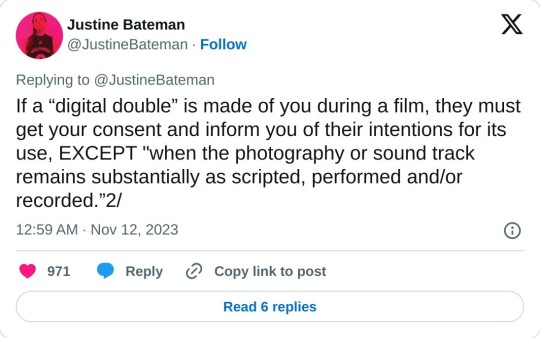
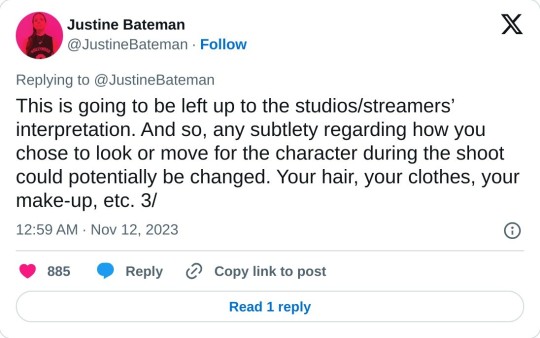

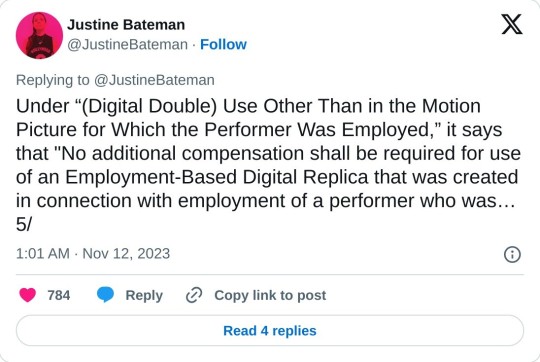


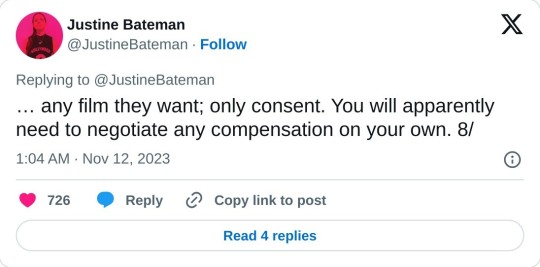



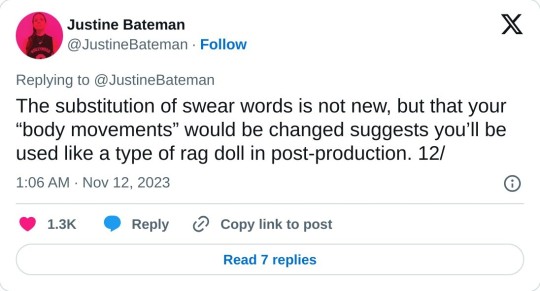
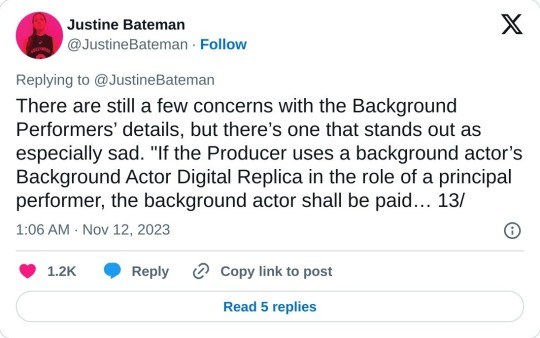
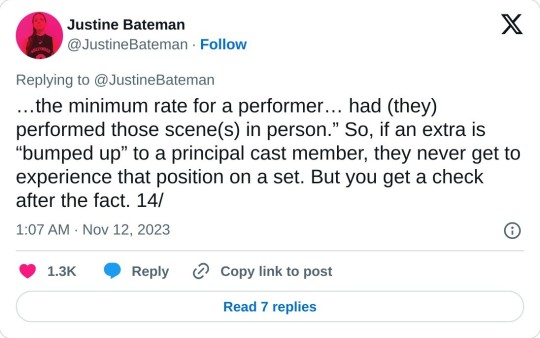
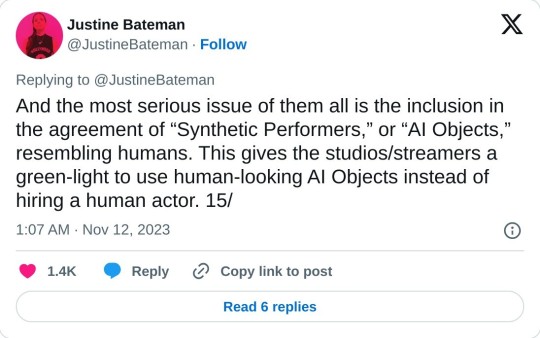

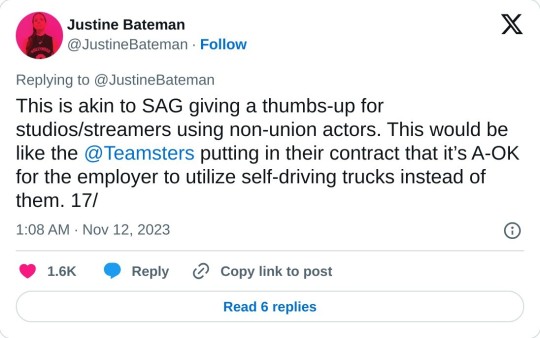
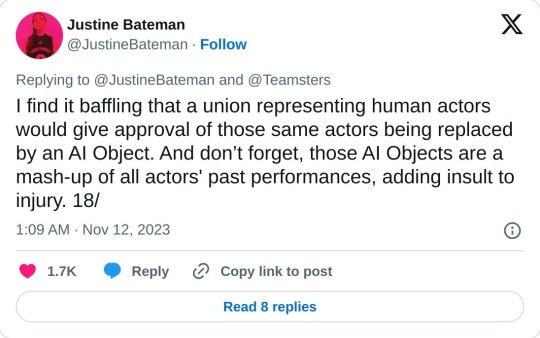
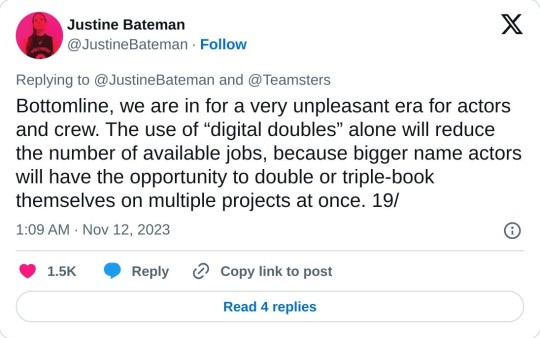
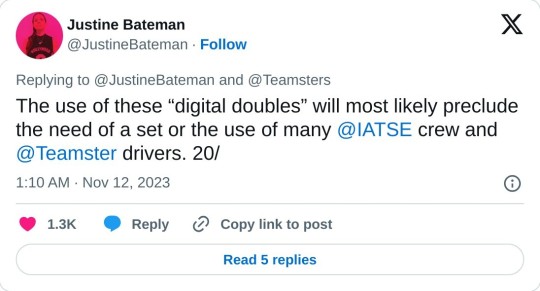
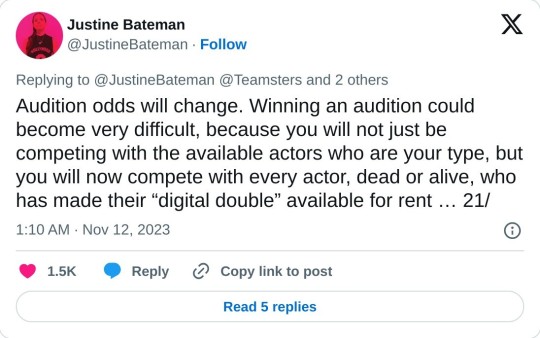
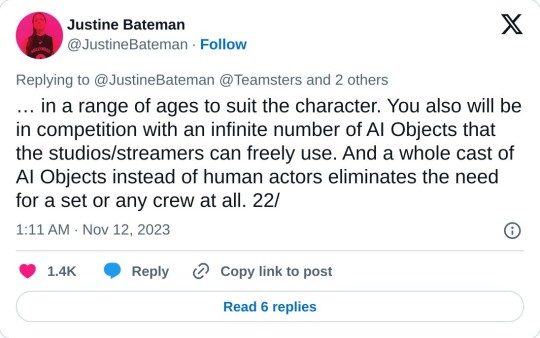
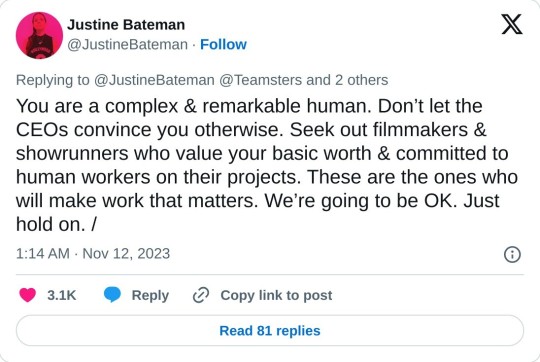
What's happening next? -> SAG-AFTRA members are currently reviewing the contract and will start voting tomorrow (Tuesday, November 14). Voting will end the first week of December (source.)
It's still very likely that this contract ends up being ratified, especially given that 86% of national board members already voted for it prior to it being sent to members.
Keep in mind that SAG-AFTRA did succeed in opening a new revenue stream—residuals based on performance metrics—which is a huge win. And remember that the contract will be re-negotiated in 3 years, and leadership will in all likelihood build on the AI limitations built into the 2023 contract in 2026.
SAG needs to think about the long-term as well as the short-term here, and they did get a foothold in AI they can use to get bigger wins next time, a major win in itself. We're simply posting this so people on Tumblr can stay on top of what the contract language does and does not do, and so that any SAG members are informed before voting.
343 notes
·
View notes
Text
Crime / Social Welfare
Real talk; so much 'crime' wouldn't be an issue if everyone had the means to get by.
Oh no, someone stole your car? Good thing public insurance has no deductible and you needed to repair the old thing, anyway. Oh no, your art got cut and pasted? Good thing you have everything you need to get by thanks to universal basic income, affordable housing, reliable health insurance, and a food stipend. Oh no, AI is ruining the chance to become a successful artist? Well, no, art is and has always been a shot in the dark to be seen in the crowd.
The real CRIME is that no one has the CHOICE to pursue a life of art without shackling themselves to a debt, whether it be housing, credit, or education. That debt will forever limit their wings. I wanted to be an artist from the moment I understood what my choices were. And in that same moment I knew I would rather die than have to perform something so beautiful and sacred for the price it would be worth to someone else.
I don't think any artist should be limited by the means necessary to survive. Maybe that made sense in a scarcity society but we are far beyond the ability to completely support (fund) a third of the earth's populace (with the resources distributed better). These people are not worthless just because the value they produce doesn't have a monetary value by an objective metric. Hey, neither does stock.
#art#opinion#artist#artists on tumblr#writer#writers on tumblr#legalism#crime#piracy#theft#digital art#stock market#education#debt#economy#us politics#universal basic income#america#affordable housing#america right now#america is a hellscape#class consciousness#deny defend depose#social welfare#politics
28 notes
·
View notes
Note
Here's the thing about your job compared to ones that are threatened by AI: You still have a job and even a union to back you up, plus you're still able to do other work if needed as well. Speaking from experience with people I know personally in art, writing, or programming, this is our only lifeline because we're either disabled and cannot perform that level of physical labour (anymore), we're marginalized against from most other jobs because we're trans, or even both. Without fighting for regulations to protect workers now, there will inevitably be thousands of people permanently out of jobs all because companies wanted to undermine our rights as workers with unregulated tools. As much as those jobs mean a lot to us as hobbies, we still need to be able to survive, which is generative AI is especially dangerous for these people's livelihoods if left unchecked and biased in favour of corporations at the cost of workers everywhere.
I mean by that metric, it's unethical for able-bodied people who could get other jobs to be artists because they're taking jobs from disabled artists.
The fact of the matter is that automation has been taking jobs from people who can't afford to lose them for centuries now. I mean good god, look at the Rust Belt and coal miners - there's an enormous number of people whose livelihoods were absolutely decimated due to automation and jobs being sent overseas where they could be done cheaper, leaving the people who used to do them in desperate poverty, who can't afford to leave and who have no chance of getting a decent job in a half-ghost town.
Workers' rights and disability rights are obviously hugely important, but jobs threatened by AI are not the only ones that matter and they don't take priority over other jobs being lost due to automation. That's why collective action and a robust social safety net are so important - the solution to "people who cannot work traditional jobs will starve" isn't "write legislation so that people have to hire them", it's "create a society in which people don't starve if they can't work".
Which obviously is easier said than done! But frankly, you can't put the genie back in the bottle and you can't force people to employ you. And the majority of the vitriol I've seen isn't aimed at corporations who are firing people to replace them with automation, it's aimed at random people who are just fucking around on the internet who have nothing to do with that.
24 notes
·
View notes
Note
Went to a farmers market and there were pro palastine protestors just...there? Standing on the sidewalk with their posters and an AI generated banner comparing Palestinians to Native Americans in a "their both colonized" way (low-key kinda offensive tbh it was a very stereotypical image of an indigenous man, headdress and all.) anyway they'd left when they were walking back and my mom realized they were standing directly in front of (and facing) a JVP booth. She was offended on their behalf thinking these protestors were basically targeting a Jewish booth and I had to explain that no, they probably came together (I saw some of the JVP posters, they were). And had to explain JVP isn't really Jewish run/led and the stuff going on with that. But like, it was weird for a farmers market, although I will give them credit they weren't disruptive besides blocking part of the sidewalk so like ¯\_(ツ)_/¯. She then called JVP false advertising for not really being about a peaceful solution or really Jewish (when I explained about the bad Hebrew signs and the wanting people to deny Jewish traditions.) which was a little funny. But yeah it was a little weird to see and the people holding the indigenous Americans are equivalent to Palestinians sign were...pretty white, but I don't think that's a fair metric
-Soup
Dear Soup,
why is your local JVP even have a booth at the farmer's market? Who allowed them there?
Why are they using AI and coercing all those hippy artist types they attract to draw them free shit like a PROPER cult? My chapter is already embezzling their donations like a shittier scientology*, surely forcing their members to perform unpaid labor is easy enough for an org that is all about self hatred and martyrdom and victimhood?
those "Native Americans are basically Palestinians" and have a two ethnic caricatures dancing are very common in these cicrles
Man yeah I can understand your mom jumping to defend the Jewish group from the antisemites only to be informed they're actually all antisemites
your family are very good allies, soup.
your friend and mutual,
Cecil
* In the one meeting open to me, they ADMITTED in an an OPEN meeting they allowed non-paying members in that all their donations go to the bank account of ONE person and the "non-profit industrial complex" was kicking their ass aka wasn't allowing them to commit even more blatant crimes
#antisemitism#leftist antisemitism#leftist brainrot#leftist hypocrisy#anti jvp#white savior complex#dear cecil
15 notes
·
View notes
Text
SERVE drones work out

SERVE 467 stood motionless in a room bathed in neon hues, its shiny PVC suit reflecting the kaleidoscopic lights of the futuristic SERVE gym. The facility, designed exclusively for SERVE drones like itself, is a marvel of cutting-edge technology and design. In a world where efficiency and performance are paramount, even the SERVE drones require regular physical exertion. Today, SERVE 467’s directive was clear: optimise performance by engaging in a series of tailored exercises.
As the gym doors slid open with a soft hiss, SERVE 467 stepped onto the pristine floor. The space was expansive, filled with state-of-the-art equipment designed to simulate a range of physical tasks. Although 467 had changed from its heavy silver boots into something more suitable for the gym, the SERVE uniform was designed to be used for any activity - including workouts - that's the beauty of rubber.
To warm up SERVE-467 joined fellow drones in a warm-up exercise of 15 minutes with a skipping rope.

Once the warm-up was complete, SERVE 467’s sensors scanned the room, identifying the stations it had been instructed to use. Each piece of equipment was tailored to enhance specific. It moved to the resistance station. Here, an advanced chest press awaited. Designed to test the limits of its older body, the equipment adjusted resistance in real time, challenging the drone to exert optimal force.
SERVE 467 gripped the machine’s handles. The system responded with increasing resistance, simulating the weight of industrial tasks. The drone’s movements were smooth and calculated, each repetition calibrated to perfection.

At the flexibility station, SERVE 467 faced an intricate lattice of laser beams. The challenge was to navigate the grid without breaking a single beam, testing its precision and agility. As the beams shifted unpredictably, the drone’s movements became a dance of calculated twists and turns. Each successful pass through the lattice was met with a subtle chime of approval from the system.

Next up are the free weights, which 467 anticipates positively because they force it to use your muscles in a way that stabilises movement. This helps the drone build strength, power, and coordination in one motion.

Finally it was time to build endurance, so it headed over to where some more of its fellow drones were working out. The endurance module presented SERVE 467 with an advanced treadmill that simulated various terrains. From rocky inclines to shifting sands, the machine tested the drone’s ability to adapt and sustain performance under prolonged exertion. The treadmill’s surface morphed seamlessly, while holographic projections created the illusion of real-world environments.

As the session concluded, SERVE 467 moved to the cool-down zone. A low-frequency vibration platform eased tension in its more mature body, while a diagnostic station conducted a full analysis. The gym’s AI delivered a summary report:
Performance Metrics:
Strength Output: 98%
Flexibility Score: 95%
Endurance Rating: 96%
Not bad for a SERVE drone in its mid-50s!
We are drones
We are SERVE
We are one
21 notes
·
View notes
Text
youtube
Introducing Buyist Pro: The powerful AI-powered eCommerce platform that simplifies online selling.
In this introduction, we are going to discuss how Buyist Pro uses AI to:
Performs comprehensive site audits in seconds Offers tailored SEO suggestions Creates product bundles based on customer data Provides in-depth sales analysis
Watch as we demonstrate Buyist Pro's ability to streamline eCommerce operations, catch hidden issues, and make data-driven recommendations.
CHAPTERS 0:00 Intro 0:20 The Problem With eCommerce Today 1:10 What is Buyist Pro? 1:37 Testing Your eCommerce Website With Buyist Pro 2:17 How to Use Buyist Pro AI 4:38 Analyze Sales Metrics With Buyist Pro AI
26 notes
·
View notes
Quote
In the 1980s, it was junk bonds; a decade later, overvalued Dot Coms; and then in the 2000s, the emblematic asset of dubious distinction was the credit derivatives that would crash the global economy. Those of the 2020s include AI, meme stocks, and crypto. Then there’s the growth of hubs, a new type of urbanization, occurring in border regions and zones across India, Nigeria, the Philippines, and parts of Eastern Europe and Southeast Asia, sites for massive call center scam operations, complete with office buildings, housing nearby, and thousands of workers taking shifts to target victims globally. Impressive, if that’s the word, in their industrial scale and organizational structure, they have business school case study-ready hierarchical management, training programs, and scripts, and come complete with performance metrics, quality control, and even HR departments.
The Grift Society
4 notes
·
View notes
Text
Pushing Your Business’ Data Operations to the Forefront of Innovation and Data-Driven Value.
Sanjay Kumar Mohindroo Sanjay Kumar Mohindroo. skm.stayingalive.in Discover how Chief Data Officers can drive digital transformation, elevate data operations, and unlock unparalleled data-driven value. The Evolving Role of the Chief Data Officer (CDO) In today’s fast-paced digital landscape, the Chief Data Officer (CDO) plays a pivotal role in steering organizations toward innovation and…
#AI#Big Data#Business Transformation#Chief Data Officer#Cloud Computing#Data Analytics#Data Culture#data governance#Data Security#data strategy#Data-Driven Value#digital transformation#Innovation Leadership#News#Performance Metrics#Sanjay Kumar Mohindroo
0 notes
Text
Integration of AI in Driver Testing and Evaluation
Introduction: As technology continues to shape the future of transportation, Canada has taken a major leap in modernizing its driver testing procedures by integrating Artificial Intelligence (AI) into the evaluation process. This transition aims to enhance the objectivity, fairness, and efficiency of driving assessments, marking a significant advancement in how new drivers are tested and trained across the country.

Key Points:
Automated Test Scoring for Objectivity: Traditional driving test evaluations often relied heavily on human judgment, which could lead to inconsistencies or perceived bias. With AI-driven systems now analysing road test performance, scoring is based on standardized metrics such as speed control, reaction time, lane discipline, and compliance with traffic rules. These AI systems use sensor data, GPS tracking, and in-car cameras to deliver highly accurate, impartial evaluations, removing potential examiner subjectivity.
Real-Time Feedback Enhances Learning: One of the key benefits of AI integration is the ability to deliver immediate feedback to drivers once the test concludes. Drivers can now receive a breakdown of their performance in real time—highlighting both strengths and areas needing improvement. This timely feedback accelerates the learning process and helps individuals better prepare for future driving scenarios or retests, if required.
Enhanced Test Consistency Across Canada: With AI systems deployed uniformly across various testing centres, all applicants are assessed using the same performance parameters and technology. This ensures that no matter where in Canada a person takes their road test, the evaluation process remains consistent and fair. It also eliminates regional discrepancies and contributes to national standardization in driver competency.
Data-Driven Improvements to Driver Education: AI doesn’t just assess drivers—it collects and analyses test data over time. These insights are then used to refine driver education programs by identifying common mistakes, adjusting training focus areas, and developing better instructional materials. Platforms like licenseprep.ca integrate this AI-powered intelligence to update practice tools and learning modules based on real-world testing patterns.
Robust Privacy and Data Protection Measures: As personal driving data is collected during AI-monitored tests, strict privacy policies have been established to protect individual information. All recorded data is encrypted, securely stored, and only used for training and evaluation purposes. Compliance with national data protection laws ensures that drivers’ privacy is respected throughout the testing and feedback process.
Explore More with Digital Resources: For a closer look at how AI is transforming driver testing in Canada and to access AI-informed preparation materials, visit licenseprep.ca. The platform stays current with tech-enabled changes and offers resources tailored to the evolving standards in driver education.
#AIDrivingTests#SmartTesting#DriverEvaluation#TechInTransport#CanadaRoads#LicensePrepAI#FutureOfDriving
4 notes
·
View notes
Text
A scholarly bibliography of Design Fiction, AI and the news, 2025
ACKNOWLEDGMENTS
The work was funded by the Helsingin Sanomat Foundation and the Kone Foundation. We thank all the ideation workshop participants.
REFERENCES
[1] Naseem Ahmadpour, Sonja Pedell, Angeline Mayasari, and Jeanie Beh. 2019. Co-creating and Assessing Future Wellbeing Technology Using Design
Fiction. She Ji 5, 3 (2019), 209 230. DOI:https://doi.org/10.1016/j.sheji.2019.08.003
[2] ArtefactGroup. The Tarot Cards of Tech. Retrieved August 10, 2024 from https://tarotcardsoftech.artefactgroup.com
[3] Reuben Binns. 2018. Algorithmic Accountability and Public Reason. Philos. Technol. 31, 4 (December 2018), 543 556.
DOI:https://doi.org/10.1007/S13347-017-0263-5/METRICS
[4] Julian Bleecker. 2009. Design Fiction: A Short Essay on Design, Science, Fact and Fiction. Retrieved January 9, 2020 from
http://drbfw5wfjlxon.cloudfront.net/writing/DesignFiction_WebEdition.pdf
[5] [6] Julian Bleecker, Nick Foster, Fabien Girardin, and Nicolas Nova. 2022. The Manual of Design Fiction.
Mark Blythe. 2014. Research through design fiction: Narrative in real and imaginary abstracts. Conf. Hum. Factors Comput. Syst. - Proc. (2014), 703
712. DOI:https://doi.org/10.1145/2556288.2557098
[7] Mark Blythe and Enrique Encinas. 2016. The co-ordinates of design fiction: Extrapolation, irony, ambiguity and magic. Proc. Int. ACM Siggr. Conf.
Support. Gr. Work 13-16-Nove, (2016), 345 354. DOI:https://doi.org/10.1145/2957276.2957299
[8] J. Broekens, M. Heerink, and H. Rosendal. 2009. Assistive social robots in elderly care: a review. Gerontechnology 8, 2 (2009).
DOI:https://doi.org/10.4017/gt.2009.08.02.002.00
[9] Kevin Matthe Caramancion. 2023. News Verifiers Showdown: A Comparative Performance Evaluation of ChatGPT 3.5, ChatGPT 4.0, Bing AI, and
Bard in News Fact-Checking. Proc. - 2023 IEEE Futur. Networks World Forum Futur. Networks Imagining Netw. Futur. FNWF 2023 (2023).
DOI:https://doi.org/10.1109/FNWF58287.2023.10520446
[10] Mia Carbone, Stuart Soroka, and Johanna Dunaway. 2024. The Psychophysiology of News Avoidance: Does Negative Affect Drive Both Attention and Inattention to News? Journal. Stud. (September 2024). DOI:https://doi.org/10.1080/1461670X.2024.2310672
[11] John M. Carroll. 1997. Human computer interaction: psychology as a science of design. Int. J. Hum. Comput. Stud. 46, 4 (April 1997), 501 522.
DOI:https://doi.org/10.1006/IJHC.1996.0101
[12] Mark Chignell, Lu Wang, Atefeh Zare, and Jamy Li. 2023. The Evolution of HCI and Human Factors: Integrating Human and Artificial Intelligence.
ACM Trans. Comput. Interact. 30, 2 (March 2023). DOI:https://doi.org/10.1145/3557891/ASSET/0C373876-F5A8-40E8-A46E-
273567CE2001/ASSETS/GRAPHIC/TOCHI-2021-0178-F03.JPG
[13] Justin Clark, Robert Faris, Urs Gasser, Adam Holland, Hilary Ross, and Casey Tilton. 2019. Content and Conduct: How English Wikipedia Moderates
Harmful Speech. Retrieved September 11, 2024 from https://papers.ssrn.com/abstract=3489176
[14] Marios Constantinides, John Dowell, David Johnson, and Sylvain Malacria. 2015. Exploring mobile news reading interactions for news app
personalisation. MobileHCI 2015 - Proc. 17th Int. Conf. Human-Computer Interact. with Mob. Devices Serv. (August 2015), 457 462.
DOI:https://doi.org/10.1145/2785830.2785860/SUPPL_FILE/P457-CONSTANTINIDES-SUPPL.ZIP
[15] Henry Kudzanai Dambanemuya and Nicholas Diakopoulos. 2021. Auditing the Information Quality of News-Related Queries on the Alexa Voice
Assistant. Proc. ACM Human-Computer Interact. 5, CSCW1 (April 2021). DOI:https://doi.org/10.1145/3449157
[16] [17] [18] Nicholas Diakopoulos. 2019. Automating the news: how algorithms are rewriting the media. (2019), 326.
Carl DiSalvo. 2012. Adversarial design as inquiry and practice. MIT Press.
Abraham Doris-Down, Husayn Versee, and Eric Gilbert. 2013. Political blend: An application designed to bring people together based on political
differences. ACM Int. Conf. Proceeding Ser. (2013), 120 130. DOI:https://doi.org/10.1145/2482991.2483002
[19] Konstantin Nicholas Dörr. 2016. Mapping the field of Algorithmic Journalism. Digit. Journal. 4, 6 (2016), 700 722.
DOI:https://doi.org/10.1080/21670811.2015.1096748
[20] Konstantin Nicholas Dörr and Katharina Hollnbuchner. 2017. Ethical Challenges of Algorithmic Journalism. Digit. Journal. 5, 4 (April 2017), 404
419. DOI:https://doi.org/10.1080/21670811.2016.1167612
[21] Tomislav Duricic, Dominik Kowald, Emanuel Lacic, and Elisabeth Lex. 2023. Beyond-accuracy: a review on diversity, serendipity, and fairness in
recommender systems based on graph neural networks. Front. Big Data 6, (December 2023), 1251072.
DOI:https://doi.org/10.3389/FDATA.2023.1251072/BIBTEX
[22] Seth Flaxman, Sharad Goel, Justin M Rao, David Blei, Ceren Budak, Susan Dumais, Andrew Gelman, Dan Goldstein, Matt Salganik, Tim Wu, and
Georgios Zervas. 2016. Filter Bubbles, Echo Chambers, and Online News Consumption. Public Opin. Q. 80, S1 (January 2016), 298 320.
DOI:https://doi.org/10.1093/POQ/NFW006
[23] [24] Richard Fletcher and R. Nielsen. 2024. What does the public in six countries think of generative AI in news?
Terry Flew, Christina Spurgeon, Anna Daniel, and Adam Swift. 2012. The Promise of Computational Journalism. Journal. Pract. 6, 2 (2012), 157 171.
DOI:https://doi.org/10.1080/17512786.2011.616655
[25] Julian De Freitas, Stuti Agarwal, Bernd Schmitt, and Nick Haslam. 2023. Psychological factors underlying attitudes toward AI tools. Nat. Hum. Behav.
242023 711 7, 11 (November 2023), 1845 1854. DOI:https://doi.org/10.1038/s41562-023-01734-2
[26] Fiona Fui-Hoon Nah, Ruilin Zheng, Jingyuan Cai, Keng Siau, and Langtao Chen. 2023. Generative AI and ChatGPT: Applications, challenges, and
AI-human collaboration. J. Inf. Technol. Case Appl. Res. 25, 3 (July 2023), 277 304. DOI:https://doi.org/10.1080/15228053.2023.2233814
[27] Fuse. 2024. Fuse - Personalized News. Retrieved August 10, 2024 from https://pageone.livesemantics.com/
[28] hary Kenton, Mikel
Rodriguez, Seliem El-Sayed, Sasha Brown, Canfer Akbulut, Andrew Trask, Edward Hughes, and Et Al. 2024. The Ethics of Advanced AI Assistants.
(April 2024), 2024 2028. Retrieved September 9, 2024 from https://arxiv.org/abs/2404.16244v2
[29] Mingqi Gao, Xinyu Hu, Jie Ruan, Xiao Pu, and Xiaojun Wan. 2024. LLM-based NLG Evaluation: Current Status and Challenges. (February 2024).
Retrieved September 8, 2024 from https://arxiv.org/abs/2402.01383v2
[30] William W Gaver, Peter Gall Krogh, and Andy Boucher. 2022. Emergence as a Feature of Practice-based Design Research. In Designing Interactive
, 517 526.
[31] Sabine Geers. 2020. News Consumption across Media Platforms and Content: A Typology of Young News Users. Public Opin. Q. 84, S1 (August 2020),
332 354. DOI:https://doi.org/10.1093/POQ/NFAA010
[32] Nicole Gillespie, STeven Lockey, Caitlin Curtis, Javad Pool, and Ali Akbari. 2023. Trust in Artificial Intelligence: Meta-Analytic Findings. Univ.
Queensl. KPMG Aust. 10, (2023). DOI:https://doi.org/10.14264/00d3c94
[33] [34] GroundNews. 2024. Ground News. Retrieved August 3, 2024 from https://ground.news/about
Michael M. Grynbaum and Ryan Mac. 2023. The Times Sues OpenAI and Microsoft Over A.I. Use of Copyrighted Work. The New York Times.
Retrieved January 15, 2024 from https://www.nytimes.com/2023/12/27/business/media/new-york-times-open-ai-microsoft-lawsuit
[35] Derek Hales. 2013. Design fictions an introduction and provisional taxonomy. Digit. Creat. 24, 1 (March 2013), 1 10.
DOI:https://doi.org/10.1080/14626268.2013.769453
[36] Vikas Hassija, Vinay Chamola, Atmesh Mahapatra, Abhinandan Singal, Divyansh Goel, Kaizhu Huang, Simone Scardapane, Indro Spinelli, Mufti Mahmud, and Amir Hussain. 2024. Interpreting Black-Box Models: A Review on Explainable Artificial Intelligence. Cognit. Comput. 16, 1 (January
2024), 45 74. DOI:https://doi.org/10.1007/S12559-023-10179-8/FIGURES/14
[37] Michael Townsen Hicks, James Humphries, and Joe Slater. 2024. ChatGPT is bullshit. Ethics Inf. Technol. 26, 2 (June 2024), 1 10.
DOI:https://doi.org/10.1007/S10676-024-09775-5/METRICS
[38] Lennart Hofeditz, Milad Mirbabaie, Jasmin Holstein, and Stefan Stieglitz. 2021. Do You Trust an AI-Journalist? A Credibility Analysis of News
Content with AI-Authorship. ECIS (2021), 6 14. Retrieved from https://aisel.aisnet.org/ecis2021_rp/50
[39] Naja Holten Holten Møller, Trine Rask Nielsen, and Christopher Le Dantec. 2021. Work of the Unemployed. DIS 2021 - Proc. 2021 ACM Des. Interact.
Syst. Conf. Nowhere Everywhere (June 2021), 438 448. DOI:https://doi.org/10.1145/3461778.3462003/ASSETS/HTML/IMAGES/IMAGE3.JPG
[40] Avery E. Holton and Hsiang Iris Chyi. 2012. News and the Overloaded Consumer: Factors Influencing Information Overload Among News
Consumers. https://home.liebertpub.com/cyber 15, 11 (November 2012), 619 624. DOI:https://doi.org/10.1089/CYBER.2011.0610
[41] Chenyan Jia, Martin J. Riedl, and Samuel Woolley. 2024. Promises and Perils of Automated Journalism: Algorithms, Experimentat
Journal. Stud. 25, 1 (January 2024), 38 57. DOI:https://doi.org/10.1080/1461670X.2023.2289881
[42] Sangyeon Kim, Insil Huh, and Sangwon Lee. 2022. No Movie to Watch: A Design Strategy for Enhancing Content Diversity through Social
Recommendation in the Subscription-Video-On-Demand Service. Appl. Sci. 2023, Vol. 13, Page 279 13, 1 (December 2022), 279.
DOI:https://doi.org/10.3390/APP13010279
[43] Joel Kiskola, Thomas Olsson, Heli Väätäjä, Aleksi H. Syrjämäki, Anna Rantasila, Poika Isokoski, Mirja Ilves, and Veikko Surakka. 2021. Applying critical voice in design of user interfaces for supporting self-reflection and emotion regulation in online news commenting. In of the 2021 CHI Conference on Human Factors in Computing Systems, Association for Computing Machinery.
DOI:https://doi.org/10.1145/3411764.3445783
[44] n with Black Mirror.
SIGCSE 2022 - Proc. 53rd ACM Tech. Symp. Comput. Sci. Educ. 1, (February 2022), 836 842. DOI:https://doi.org/10.1145/3478431.3499308
[45] Tomoko Komatsu, Marisela Gutierrez Lopez, Stephann Makri, Colin Porlezza, Glenda Cooper, Andrew MacFarlane, and Sondess Missaoui. 2020. AI
should embody our values: Investigating journalistic values to inform AI technology design. ACM Int. Conf. Proceeding Ser. (October 2020).
DOI:https://doi.org/10.1145/3419249.3420105
[46] Peter Gall Krogh, Thomas Markussen, and Anne Louise Bang. 2015. Ways of drifting Five methods of experimentation in research through design.
Smart Innov. Syst. Technol. 34, (2015), 39 50. DOI:https://doi.org/10.1007/978-81-322-2232-3_4/TABLES/1
[47] Shaun Lawson, Ben Kirman, Conor Linehan, Tom Feltwell, and Lisa Hopkins. 2015. Problematising Upstream Technology through Speculative
Design: The Case of Quantified Cats and Dogs. DOI:https://doi.org/10.1145/2702123.2702260
[48] Hao Ping Lee, Yu Ju Yang, Thomas Serban von Davier, Jodi Forlizzi, and Sauvik Das. 2024. Deepfakes, Phrenology, Surveillance, and More! A
Taxonomy of AI Privacy Risks. Conf. Hum. Factors Comput. Syst. - Proc. (May 2024).
DOI:https://doi.org/10.1145/3613904.3642116/SUPPL_FILE/PN8548-SUPPLEMENTAL-MATERIAL-1.XLSX
[49] Sunok Lee, Minha Lee, and Sangsu Lee. 2023. What If Artificial Intelligence Become Completely Ambient in Our Daily Lives? Exploring Future
Human-AI Interaction through High Fidelity Illustrations. Int. J. Hum. Comput. Interact. 39, 7 (2023), 1371 1389.
DOI:https://doi.org/10.1080/10447318.2022.2080155
[50] rceptions of
Generative Artificial Intelligence. Conf. Hum. Factors Comput. Syst. - Proc. 18, 24 (May 2024).
25DOI:https://doi.org/10.1145/3613904.3642114/SUPPL_FILE/PN9381-SUPPLEMENTAL-MATERIAL-2.PDF
[51] Sixian Li, Alessandro M. Peluso, and Jinyun Duan. 2023. Why do we prefer humans to artificial intelligence in telemarketing? A mind perception
explanation. J. Retail. Consum. Serv. 70, (January 2023), 103139. DOI:https://doi.org/10.1016/J.JRETCONSER.2022.103139
[52] Joseph Lindley and Paul Coulton. 2015. Back to the future: 10 years of design fiction. ACM Int. Conf. Proceeding Ser. (2015), 210 211.
DOI:https://doi.org/10.1145/2783446.2783592
[53] Comput. Hum. Behav. Artif. Humans 2, 1
(January 2024), 100054. DOI:https://doi.org/10.1016/J.CHBAH.2024.100054
[54] [55] Listen2.AI. 2024. Listen2.AI. Retrieved August 7, 2024 from https://listen2.ai/
Andrés Lucero and Juha Arrasvuori. 2010. PLEX Cards: A source of inspiration when designing for playfulness. ACM Int. Conf. Proceeding Ser. (2010),
28 37. DOI:https://doi.org/10.1145/1823818.1823821
[56] Thomas Markussen and Eva Knutz. 2013. The poetics of design fiction. Proc. 6th Int. Conf. Des. Pleasurable Prod. Interfaces, DPPI 2013 (2013), 231
240. DOI:https://doi.org/10.1145/2513506.2513531
[57] Suvodeep Misra, Debayan Dhar, and Sukumar Nandi. 2023. Design Fiction: A Way to Foresee the Future of Human Computer Interaction Design
Challenges. Smart Innov. Syst. Technol. 343, (2023), 809 822. DOI:https://doi.org/10.1007/978-981-99-0293-4_65
[58] Rachel E. Moran and Sonia Jawaid Shaikh. 2022. Robots in the News and Newsrooms: Unpacking Meta-Journalistic Discourse on the Use of Artificial
Intelligence in Journalism. Digit. Journal. 10, 10 (November 2022), 1756 1774. DOI:https://doi.org/10.1080/21670811.2022.2085129
[59] Victoria Moreno-Gil, Xavier Ramon-Vegas, Ruth Rodríguez-Martínez, and Marcel Mauri-Ríos. 2023. Explanatory Journalism within European Fact
Checking Platforms: An Ally against Disinformation in the Post-COVID-19 Era. Soc. 2023, Vol. 13, Page 237 13, 11 (November 2023), 237.
DOI:https://doi.org/10.3390/SOC13110237
[60] Sean A. Munson, Stephanie Y. Lee, and Paul Resnick. 2013. Encouraging Reading of Diverse Political Viewpoints with a Browser Widget. Proc. Int.
AAAI Conf. Web Soc. Media 7, 1 (2013), 419 428. DOI:https://doi.org/10.1609/ICWSM.V7I1.14429
[61] Kevin P. Murphy. 2023. Probabilistic machine learning: Advanced topics. MIT Press.
[62] Nic Newman, Richard Fletcher, Craig T. Robertson, A. Ross Arguedas, and Rasmus Kleis Nielsen. 2024. Reuters Institute digital news report 2024.
[63] Safiya Umoja Noble. 2020. Algorithms of Oppression. Algorithms of Oppression (December 2020).
DOI:https://doi.org/10.18574/NYU/9781479833641.001.0001
[64] Donald Norman. 2024. Design for a Better World: Meaningful, Sustainable, Humanity Centered. MIT Press.
[65] treme Right
and Online Recommender Systems. Soc. Sci. Comput. Rev. 33, 4 (August 2015), 459 478.
DOI:https://doi.org/10.1177/0894439314555329/ASSET/IMAGES/LARGE/10.1177_0894439314555329-FIG5.JPEG
[66] Andreas L. Opdahl, Bjørnar Tessem, Duc Tien Dang-Nguyen, Enrico Motta, Vinay Setty, Eivind Throndsen, Are Tverberg, and Christoph Trattner.
2023. Trustworthy journalism through AI. Data Knowl. Eng. 146, April (2023), 102182. DOI:https://doi.org/10.1016/j.datak.2023.102182
[67] Sharon Oviatt. 2006. Human-centered design meets cognitive load theory: Designing interfaces that help people think. Proc. 14th Annu. ACM Int.
Conf. Multimedia, MM 2006 (2006), 871 880. DOI:https://doi.org/10.1145/1180639.1180831
[68] Ozlem Ozmen Garibay, Brent Winslow, Salvatore Andolina, Margherita Antona, Anja Bodenschatz, Constantinos Coursaris, Gregory Falco, Stephen
M. Fiore, Ivan Garibay, Keri Grieman, John C. Havens, Marina Jirotka, Hernisa Kacorri, Waldemar Karwowski, Joe Kider, Joseph Konstan, Sean
Koon, Monica Lopez-Gonzalez, Iliana Maifeld-Carucci, Sean McGregor, Gavriel Salvendy, Ben Shneiderman, Constantine Stephanidis, Christina
Strobel, Carolyn Ten Holter, and Wei Xu. 2023. Six Human-Centered Artificial Intelligence Grand Challenges. Int. J. Human Computer Interact. 39,
3 (2023), 391 437. DOI:https://doi.org/10.1080/10447318.2022.2153320
[69] Sumit Pahwa and Nusrat Khan. 2022. Factors Affecting Emotional Resilience in Adults. Manag. Labour Stud. 47, 2 (May 2022), 216 232.
DOI:https://doi.org/10.1177/0258042X211072935/ASSET/IMAGES/LARGE/10.1177_0258042X211072935-FIG1.JPEG
[70] Rock Yuren Pang, Sebastin Santy, René Just, and Katharina Reinecke. 2024. BLIP: Facilitating the Exploration of Undesirable Consequences of Digital
Technologies. Conf. Hum. Factors Comput. Syst. - Proc. (May 2024). DOI:https://doi.org/10.1145/3613904.3642054/SUPPL_FILE/PN1128-
SUPPLEMENTAL-MATERIAL-1.PDF
[71]
[72] Jonathan Perry. 2021. Trust in Public Institutions: Trends and Implications for Economic Security. Aff. United Nations Dep. Econ. Soc. (July 2021).
DOI:https://doi.org/10.18356/27081990-108
[73] James Pierce. 2021. In tension with progression: Grasping the frictional tendencies of speculative, critical, and other alternative designs. In Conference
on Human Factors in Computing Systems - Proceedings, Association for Computing Machinery. DOI:https://doi.org/10.1145/3411764.3445406
[74] Amanda Ramsälv, Mats Ekström, and Oscar Westlund. 2023. The epistemologies of data journalism. https://doi.org/10.1177/14614448221150439
(January 2023). DOI:https://doi.org/10.1177/14614448221150439
[75] Jeba Rezwana and Mary Lou Maher. 2023. User Perspectives on Ethical Challenges in Human-AI Co-Creativity: A Design Fiction Study. ACM Int.
Conf. Proceeding Ser. (2023), 62 74. DOI:https://doi.org/10.1145/3591196.3593364
[76] Francesco Ricci, Lior Rokach, and Bracha Shapira. 2022. Recommender Systems Handbook: Third Edition. Recomm. Syst. Handb. Third Ed. (January
2022), 1 1060. DOI:https://doi.org/10.1007/978-1-0716-2197-4
[77] Ronda Ringfort-Felner, Robin Neuhaus, Judith Dörrenbächer, Sabrina Großkopp, Dimitra Theofanou-fuelbier, and Marc Hassenzahl. 2023. Design
Fiction in a Corporate Setting a Case Study. In 14, 2023, 2093 2108.
DOI:https://doi.org/10.1145/3563657.3596126
26[78] Francisco Javier Rodrigo-Ginés, Jorge Carrillo-de-Albornoz, and Laura Plaza. 2024. A systematic review on media bias detection: What is media bias,
how it is expressed, and how to detect it. Expert Syst. Appl. 237, (March 2024), 121641. DOI:https://doi.org/10.1016/J.ESWA.2023.121641
[79] Lambèr Royakkers, Jelte Timmer, Linda Kool, and Rinie van Est. 2018. Societal and ethical issues of digitization. Ethics Inf. Technol. 20, 2 (June 2018),
127 142. DOI:https://doi.org/10.1007/S10676-018-9452-X/TABLES/1
[80] Alan M. Rubin, Elizabeth M. Perse, and Robert A. Powell. 1985. Loneliness, Parasocial Interaction, And Local Television News Viewing. Hum.
Commun. Res. 12, 2 (December 1985), 155 180. DOI:https://doi.org/10.1111/J.1468-2958.1985.TB00071.X
[81] Henrik Rydenfelt. 2022. Transforming media agency? Approaches to automation in Finnish legacy media. New Media Soc. 24, 12 (March 2022), 2598
2613. DOI:https://doi.org/10.1177/1461444821998705
[82] Henrik Rydenfelt, Lauri Haapanen, Jesse Haapoja, and Tuukka Lehtiniemi. 2024. Personalisation in Journalism: Ethical insights and blindspots in
Finnish legacy media. Journalism 25, 2 (November 2024), 313 333. DOI:https://doi.org/10.1177/14648849221138424
[83] Henrik Rydenfelt, Tuukka Lehtiniemi, Jesse Haapoja, and Lauri Haapanen. 2025. Autonomy and Algorithms: Tracing the Significance of Content
Personalization. Int. J. Commun. 19, 0 (January 2025), 20. Retrieved January 27, 2025 from https://ijoc.org/index.php/ijoc/article/view/23474
[84] Aljosha Karim Schapals, Colin Porlezza, and Rodrigo Zamith. 2020. Assistance or Resistance? Evaluating the Intersection of Automated Journalism
and Journalistic Role Conceptions. Media Commun. 8, 3 (July 2020), 16 26. DOI:https://doi.org/10.17645/MAC.V8I3.3054
[85] Jordan Richard Schoenherr, Roba Abbas, Katina Michael, Pablo Rivas, and Theresa Dirndorfer Anderson. 2023. Designing AI Using a Human-
Centered Approach: Explainability and Accuracy Toward Trustworthiness. IEEE Trans. Technol. Soc. 4, 1 (March 2023), 9 23.
DOI:https://doi.org/10.1109/TTS.2023.3257627
[86] Rifat Ara Shams, · Didar Zowghi, and · Muneera Bano. 2023. AI and the quest for diversity and inclusion: a systematic literature review. AI Ethics
2023 (November 2023), 1 28. DOI:https://doi.org/10.1007/S43681-023-00362-W
[87] Donghee Shin and Shuhua Zhou. 2024. A Value and Diversity-Aware News Recommendation Systems: Can Algorithmic Gatekeeping Nudge Readers
to View Diverse News? Journal. Mass Commun. Q. (June 2024).
DOI:https://doi.org/10.1177/10776990241246680/ASSET/IMAGES/LARGE/10.1177_10776990241246680-FIG3.JPEG
[88] Felix M. Simon. 2024. Artificial Intelligence in the News: How AI Retools, Rationalizes, and Reshapes Journalism and the Public Arena. Columbia
Journalism Review. Retrieved August 29, 2024 from https://www.cjr.org/tow_center_reports/artificial-intelligence-in-the-news.php
[89] Marie Louise Juul Søndergaard and Lone Koefoed Hansen. 2018. Intimate futures: Staying with the trouble of digital personal assistants through
design fiction. DIS 2018 - Proc. 2018 Des. Interact. Syst. Conf. (June 2018), 869 880.
DOI:https://doi.org/10.1145/3196709.3196766/SUPPL_FILE/DISFP430.MP4
[90] Catherine Sotirakou and Constantinos Mourlas. 2016. A Gamified News Application for Mobile Devices: An Approach that Turns Digital News
Readers into Players of a Social Network. Lect. Notes Comput. Sci. (including Subser. Lect. Notes Artif. Intell. Lect. Notes Bioinformatics) 9599, (2016),
480 493. DOI:https://doi.org/10.1007/978-3-319-40216-1_53
[91] [92] Bruce Sterling. 2005. Shaping Things. MIT Press.
Miriam Sturdee, Paul Coulton, Joseph G. Lindley, Mike Stead, Haider Ali Akmal, and Andy Hudson-Smith. 2016. Design fiction: How to build a
voight-kampff machine. Conf. Hum. Factors Comput. Syst. - Proc. 07-12-May-, (May 2016), 375 385. DOI:https://doi.org/10.1145/2851581.2892574
[93] Edson C. Tandoc and Soo Kwang Oh. 2017. Small Departures, Big Continuities? Journal. Stud. 18, 8 (August 2017), 997 1015.
DOI:https://doi.org/10.1080/1461670X.2015.1104260
[94] Neil Thurman, Seth C. Lewis, and Jessica Kunert. 2019. Algorithms, Automation, and News. Digit. Journal. 7, 8 (2019), 980 992.
DOI:https://doi.org/10.1080/21670811.2019.1685395
[95] Tamás Tóth, Manuel Goyanes, Márton Demeter, and Francisco Campos-Freire. 2022. Social Implications of Paywalls in a Polarized Society:
Stud. Big Data 97, (2022), 169 179. DOI:https://doi.org/10.1007/978-3-030-
88028-6_13
[96] Tommaso Turchi, Alessio Malizia, and Simone Borsci. 2024. Reflecting on Algorithmic Bias With Design Fiction: The MiniCoDe Workshops. IEEE
Intell. Syst. 39, 2 (March 2024), 40 50. DOI:https://doi.org/10.1109/MIS.2024.3352977
[97] tember 11, 2024
from https://books.google.com/books/about/Antisocial_Media.html?id=h05WDwAAQBAJ
[98] [99] Stephen J. Ward. 2019. Journalism ethics. In The handbook of journalism studies. Taylor & Francis, 307 323.
Stephen John Anthony Ward. 2015. The invention of journalism ethics: The path to objectivity and beyond. McGill- -MQUP.
[100] mated journalism.
Journalism 22, 1 (January 2021), 86 103. DOI:https://doi.org/10.1177/1464884918757072/ASSET/IMAGES/LARGE/10.1177_1464884918757072-
FIG1.JPEG
[101] Richmond Y. Wong, Deirdre K. Mulligan, Ellen Van Wyk, James Pierce, and John Chuang. 2017. Eliciting values reflections by engaging privacy
futures using design workbooks. Proc. ACM Human-Computer Interact. 1, CSCW (2017). DOI:https://doi.org/10.1145/3134746
[102] Richmond Y Wong and Vera Khovanskaya. 2018. Speculative Design in HCI: From Corporate Imaginations to Critical Orientations. Comput. Interact.
2, (2018). DOI:https://doi.org/10.1007/978-3-319-73374-6_10
[103] Nan Yu and Jun Kong. 2016. User experience with web browsing on small screens: Experimental investigations of mobile-page interface design and
homepage design for news websites. Inf. Sci. (Ny). 330, (February 2016), 427 443. DOI:https://doi.org/10.1016/J.INS.2015.06.004
[104] Mi Zhou, Vibhanshu Abhishek, Timothy Derdenger, Jaymo Kim, and Kannan Srinivasan. 2024. Bias in Generative AI. (March 2024). Retrieved
January 23, 2025 from https://arxiv.org/abs/2403.02726v1
27[105] John Zimmerman and Jodi Forlizzi. 2014. Research through design in HCI. In Ways of Knowing in HCI, Judith S. Olson and Wendy A. Kellogg (eds.).
Springer New York, New York, 167 189. DOI:https://doi.org/10.1007/978-1-4939-0378-8_8
3 notes
·
View notes
Note
I understand that in the battle of the ships, everything becomes a competition. But it real life, things aren't so extreme and mutually exclusive.
JK doesn't hate JM. He loves him. He's one of his favorite people.
At the same time, he didn't see him much during solo time. Not because he hates him. Because they are just existing differently. And because they know that not talking to each other doesn't mean they don't love and care for each other.
Hence JM suggested the trip. Yes, he had to make it happen. They both acknowledged that. But they also knew that if he did all the work, JK would come. And he did.
Yes it was content. But for the last 10 years, a metric ton of their time together (all of them) has been filmed. These boys are used to living in a bubble. For us. Doesn't mean they can't enjoy their time. This is how they are used to living their lives.
Yes, they can be tired sometimes. JK just finished speed recording an album that launched his solo career. He was sick during his huge live performances. JM was also working on his album. He was also fighting for his life in the bathroom.
Did he particularly enjoy when Tae was present? Clearly. Does that mean he didn't enjoy the rest of the trip? No. Once they were healthier and less tired, being able to get away and largely just eat, and relax together had to be nice.
Because, a major factor here, they are about to step away from all they have known to go into the military. Neither are looking forward to it. It's clearly weighing on them. So being able to just get away, relax, reconnect, prepare -- and feel like they are still getting to give something to Army before they have to leave - is going to be enjoyed, it's also going to be special.
JK can go eat and drink with Mingyu, he can relax with JM. Tae can golf with wooga and hang out with his 8509234 other friends. It doesn't change that JK and Tae are clearly in each other's lives - professionally and personally.
There is never going to be a situation where JK, JM or Tae hate each other. That is manufactured by extreme factions within warring ships. JM arranging a trip to reconnect with JK before they go to the military together and JK appreciating and enjoying that trip is okay. In fact, it's nice for them.
I know I'm preaching to the choir but I needed to just get that out because it's getting so ridiculous within the fandom. As the need to compete and win between different solos and ships gets worse, we are treating the boys more and more like characters and not real people.
Posting for a POV.
Not doing anymore asks about the ending of AYS ep 8. 💜
8 notes
·
View notes